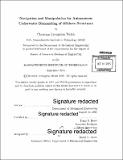Navigation and manipulation for autonomous underwater dismantling of offshore structures
Author(s)
Welch, Christian Livingston
DownloadFull printable version (13.73Mb)
Other Contributors
Massachusetts Institute of Technology. Department of Mechanical Engineering.
Advisor
Franz S. Hover.
Terms of use
Metadata
Show full item recordAbstract
The dismantling of offshore structures, known as decommissioning, is a complex task in the oil and gas industry, driven by strict environmental standards. As the environments in which decommissioning is necessary become more challenging, autonomy presents itself as a solution to conduct this work as cost-effectively and safely as possible, namely by taking Remotely Operated Vehicles (ROVs) and divers out of the equation. In this thesis, three avenues are researched in support of Autonomous Underwater Vehicles (AUVs) for decommissioning: navigation, attachment, and manipulation. First, the Iterative Closest Point method (ICP) is investigated as a means to correct position drift of an inertial navigation system, by using a previously obtained coarse map. Using real sonar data from a current decommissioning site in the Gulf of Mexico, the algorithm is able to reconcile the internally dead-reckoned pose of the vehicle with that calculated via ICP, to an accuracy of 7cm from a 100k-point sonar scan. Second, to attach lifting points to subsea scrap without bracing onto it, a single mechanism was designed to both drill and affix anchors in a single penetration, from a vehicle in free flight. A prototype was fabricated and its functionality verified. Third, to promote robust and stable robotic interactions using an industry standard non-backdrivable manipulator, a control law was developed to have the vehicle-manipulator system passively interact with its environment, by mimicking an arrangement of masses, springs, and dashpots. This control law was tested and analyzed in a simple experiment that achieved a 90% reduction in settling time.
Description
Thesis: S.M., Massachusetts Institute of Technology, Department of Mechanical Engineering, 2015. Cataloged from PDF version of thesis. Includes bibliographical references (pages 95-99).
Date issued
2015Department
Massachusetts Institute of Technology. Department of Mechanical EngineeringPublisher
Massachusetts Institute of Technology
Keywords
Mechanical Engineering.